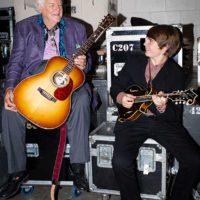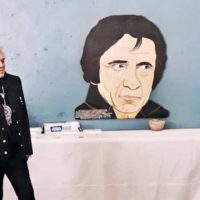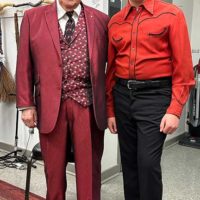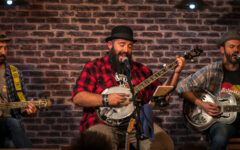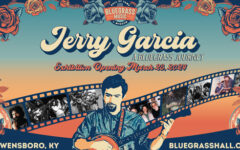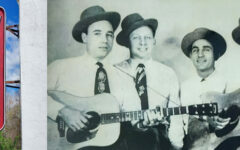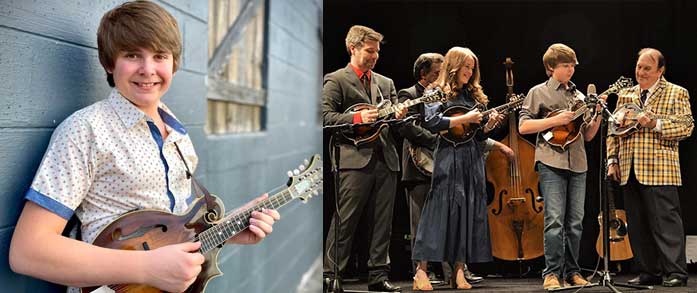
Mandolin wunderkind Wyatt Ellis from Maryville, Tennessee, had a thirteenth year full of experiences that most of us wouldn’t believe if we hadn’t seen his story unfold before us on social media. Highlights of 2022 for the young mandolin player include a full-circle Woodsongs Old-Time Radio Hour appearance with his mentor Sierra Hull, recording his first album with 12 of the world’s top mandolin players, playing Lonesome Fiddle Blues with Sam Bush to celebrate his 50 year bluegrass legacy via Michael Johnathon and Kentucky Humanities, getting a scholarship to work with Bobby Osborne from the Kentucky School of Bluegrass, kicking off CMA fest with David Harvey at the Gibson Garage, playing mandolin at Peter Rowan’s induction into the Bluegrass Hall of Fame, hiring a band for his first “grown-up” gig at The Caverns, and performing at Marty Stuart’s Grand-Reopening of the Ellis Theater. I spoke to Wyatt on a video call in early January 2023 to recap his unbelievable year and find out what led to it.
Here’s our conversation.
Did you grow up listening to bluegrass?
No. I started listening to bluegrass probably when I was about 10 years old.
What caught your attention about bluegrass? How was it different for you?
I really loved the song Rocky Top. That was before I was ten. Rocky Top was my first exposure to bluegrass. My mom has a video of me when I was two, I would sing the exact melody to Rocky Top even though I didn’t know the correct words. I loved the music even back then. She says I was always humming, especially if I was happy or eating.
Interesting. Yeah, I love that song too. Did you start playing guitar or mandolin first?
I had a toy guitar when I was little that I was obsessed with. But it was a toy, tiny and blue from Cracker Barrel. I wanted to learn to play guitar, so I took a few lessons when I was five, but my hands were too small, so I switched to piano. I got into mandolin when I was almost ten. I started on a real guitar when I was almost twelve.
I would imagine that as a ten-year-old kid there’s less of a catalog in the public for a mandolin. There aren’t any pop tunes on mainstream radio that feature a mandolin. What was it specifically about the mandolin that drew you?
It was probably Bobby Osborne’s playing.
And how did you hear that?
From Rocky Top.
Did you hear it on the radio, or YouTube, or was it a record?
Probably just football games. We’re in Knoxville, Tennessee — big orange football country — and that’s the theme song. I don’t know if you knew that, did you know?
I did not know that. That’s good to know. That’s great to know. Wow.
Yeah. So that’s why I heard it so many times because we would go to all the football games. It probably plays over fifty times at each football game, every game. If they make a touchdown, the band plays Rocky Top and sometimes they even play the Osborne Brothers version over the loudspeakers. I heard that at the games then I started to listen to bluegrass on Apple Music and other streaming services. I didn’t grow up listening to bluegrass or going to bluegrass festivals. My family learned bluegrass mainly through me once I got my mandolin. Getting to work personally with Bobby now over the past two years has been priceless. It’s an honor and has given me memories I’ll treasure for the rest of my life.
That’s so interesting. I don’t want to put you on the spot, but you talk about what the ancient tones mean to you? When I’ve talked to Peter Rowan about it, we go round and round, it goes into the nature of existence in the cosmos. That’s how far we go with it.
I bet Peter has a lot to say about that! I just got a postcard in the mail from Peter. It was a photo of him when he was a Blue Grass Boy singing with Monroe. He said I did a great job at the Awards Show and at the end he said, “You’ve got the tones, the ancient tones.” That was the best rainy-day trip to the mailbox I’ve ever had. You know, when I first heard the term ancient tones in reference to the mandolin, I thought it was very descriptive of the way Monroe played and the overall theme of his tunes. They all have that ancient feel. The moan of the fiddle and the way the mandolin rings out and has that percussive beat too. There is a lot of Native American influence in his music, so that’s what I think it means on the surface, but it can go a lot deeper than that and further back in time.
I’ve been playing guitar since I’m probably fifteen. You are a lot better than I am. You’re a terrific guitar player. Did you take guitar lessons and mandolin lessons from the same person? Did you learn both from Chris?
I got my start on guitar during the pandemic. I started with Chris Henry’s twelve-week Traditional Bluegrass Guitar Workshop. I think it was in November of 2020. I had been in Chris’s workshops already for about six months. And I decided that winter of the pandemic to do his course since he was doing one. My mom thought it might mess up my mandolin playing, but it didn’t. I studied both guitar and mandolin. I started transposing stuff I knew on mandolin to guitar. My first teacher had said early on that I had a knack for transposing keys on the mandolin really before I was taught how. I didn’t understand what I was doing. I was just doing it. When Chris started the workshop, I easily mimicked the different guitar players and could sound like any of them. My mom said when I was little, she thought I would be interested in making sound effects because I was always mimicking sounds when I played with my toys or repeating melodies I had heard. Some people can be voice impersonators and mimic. I mimic different instrumental tones and styles. I’ve also started playing fiddle now too, so I guess I’m all in. I’ve worked with some amazing guitar players and fiddlers since then too.
How did you meet Chris?
Online. Kind of through Facebook on The Monroe Mandolin Appreciation Society page. And then the workshop. Yep, everybody was stuck home. You know, when I was about five years old, in a private Christian school, I had a piano teacher who told my mom that I would never be a good musician and I would get in trouble because I “cheated” by listening instead of reading the music. When I heard what Chris was doing in his workshops, my mom and I thought that this was exactly what I had needed all along. I am glad I learned to read notation from the piano lessons, and tab from my early mandolin lessons, but I seem to learn music almost instantly by just listening.
Listening is more in the bluegrass tradition. I’ve taken lessons with Chris. He’s amazing. You guys have developed a very kind of special relationship. You’ve written songs together, right?
Yeah, Chris is an amazing musician and a great teacher. He challenges me. We’ve written some tunes and some songs together. There’s a video of one of our tunes, Whites Creek, I played recently for Mandolin Mondays, David Benedict’s YouTube series. It will also be on my upcoming album. I expect it to come out this spring. I wrote The Winds of Rowan County inspired by a windy moment after playing with Peter Rowan at IBMA. That one will have to be on another album down the road, for sure. Maybe Peter will play on it? That’d be cool.
When did you know you were going to sub for Chris at the IBMA Awards Show?
Maybe three weeks before, and at that point I thought I was only subbing for him at Peter’s induction. Then, about three days before the IBMA, I found out I was going to do a full showcase with Peter. I learned everything on his new album in three days — you know just in case.
You opened Peter’s Award Show performance with the note-for-note Monroe kick-off of Walls of Time. Did you feel a lot of pressure?
Not necessarily. It was more of an honor. I had set a goal early in my playing to learn every instrumental that Bill ever wrote as closely as I could. Now I’m going back through them even more with a fine-toothed comb. Using different resources, original recordings, and even unreleased fragments that I’m going back through with Mike Compton, too.
What’s motivating you to do that study?
If somebody in my generation doesn’t learn it, who’s going to keep it alive? Most people are playing mandolin in a more modern way. I like that too, but I think it’s important to preserve the tradition. I’m trying to keep the ancient tones alive for generations.
When asked about Wyatt, Peter Rowan had some insight into his hard to explain abilities.
“Wyatt’s understanding of the music goes way beyond mechanical; he intuits the ancient tones!”
Peter has described the ancient tones to me in another conversation:
“It wasn’t that you hear the ancient tones, and so you go and try to make them. You make the music, and the ancient tones emerge. You follow the musical rules, but you’re not invested in them. The ancient tones emerge from the application of selflessness.”
Christopher Henry has been an important mentor to Wyatt. Here’s what Christopher said when asked to describe Wyatt:
“To me, Wyatt stands out as a student because of two things: his natural talent and his inclination to work hard to develop the gift. The reason Michael Jordan became the greatest is because not only was he extraordinarily talented, but that he wanted to work harder than most folks to be as good as humanly possible. Wyatt has a bit of that going on. I don’t think anyone has learned as much of Monroe’s music so accurately by age 13, and there are very few that know as much at any age. I could hear early on that he had a knack and bent towards Monroe style, and could feel the power and beauty in the ancient tones. When you can feel it deeply like that, it can be inspiring to work on figuring out how it works.”
When I asked Christopher about the decision to have Wyatt take his place at the 2022 IBMA award show, he said:
“I thought he would be a good fit for Peter’s IBMA award show because I knew he could learn the parts note-for-note, and that he performs well under pressure. He had joined the band my dad, Red, and I lead at a show in Florida, and has good instincts on stage and is able to not be overcome with nerves. He’s also generally pleasant to be around and can conduct himself in a professional and respectful manner, and I also knew it would mean a lot to him and be helpful in his development. Our picking styles are very similar, and he probably plays more like I do than anyone else, so he was a natural fit on that count too. And he did great, and it was a beautiful and poignant occasion to have three generations on stage that night. I am always very proud of him.”
Can you tell me about the mandolin that you own? Where did you buy it?
I own a couple mandolins. My main mandolin is a 2020 Master Model that I got as I became the youngest Gibson endorsing artist, and part of the Gibson Generation Group through David Harvey. At Peter’s induction, I played a very special, very old Gibson mandolin that I got for my last birthday. Marty Stuart owned it for a few decades. He recorded on Bobby Hicks’s record with it, and recorded with it on his Pilgrim album. He’s recorded with it on other albums as well. A special part of its history to me is that Marty played it to raise money for Bill Monroe’s gravestone at a big benefit concert. It also came originally through Knoxville, Tennessee, and was first owned by a T.A. Miles in 1924. Miles was a Gibson agent and the leader of The Knoxville Mandolin Orchestra. Bobby Osborne’s Rocky Top mandolin came through Miles Music, too. It’s a very important part of East Tennessee music history.
The people who were selling it knew I was deeply interested in that mandolin, and that the history of it was very important to me. I probably played it ten different times in 2021. After a year of daydreaming, and because of my sincere interest in its history and my mandolin playing, the owner investigated what I was doing and said they’d like me to have it for the offer we had made. They told the salesman they’d like to meet me one day. I found out I was going to be getting it on the mandolin’s 98th birthday, and received it on my own birthday just a few days later. It was a big decision for my family. We sold a few things, like my fishing boat and a couple of other instruments to make it happen. It was easy for me to decide that the instrument was more important to me than the boat. I can always get another boat down the road. When I told Marty the story he agreed. He said, “You can always get another boat.” Marty was thirteen years old when he went on the road with Lester Flatt. So, there’s a cool connection there too. He’s had a fifty-year career in music and is still going strong. He started being taken seriously when he was thirteen. So, what I say to that is never underestimate a thirteen-year-old mandolin picker!
Can you tell me the story about your tune The Winds of Rowan County?
Yeah, that tune was inspired by Peter, Bill, and a little bit, by Marty Stuart. We saw Peter outside of the hotel the day after his induction on our way to his Red Hat IBMA show. He had already invited me back to play Monroe’s Frog on the Lilly Pad with Chris Henry, which was such an honor and full circle moment for me. I had just a few minutes to tell him how special it was to play with him the night before. I told him that I played the mandolin Marty had once owned. As soon as my mom said, “Marty played it at a concert to raise funds for Bill Monroe’s gravestone,” Peter’s hat was blown right off his head. Struck by a big wind, It must have gone 20 feet. He looked at us smiling and said, “You said Bill Monroe’s name.”
What a great story! How did you get to meet Marty Stuart and Ricky Skaggs?
Marty invited me to play at his grand reopening of a historic theater that he renovated in Phase I of his Congress of Country Music project, called The Ellis Theater, of all things. Marty said he had been hearing about me from lots of different people, so he wanted to meet me for himself. Marty’s idea was to have me play in the newly restored lobby before each show. Marty, Ricky, Vince Gill, and The Gaithers. I was playing solo mandolin before legends. I also had my own tent show and another show on Saturday night at a party with maybe 100 of Marty’s closest friends — no pressure there, right? I played some note-for-note Monroe tunes like Mississippi Waltz and My Last Days on Earth. I also played some of my own original tunes. In the middle of my set, I shared the stage there with another special guest, a lady named Dorothy Moore, who’s a wonderful blues singer from down in Mississippi. She sang her hit, Misty Blue, while I was right there beside her. That was cold chills for sure!
What do you do when you’re not playing music?
I practice Taekwondo. And I love golf and fishing. And watching sports!
In addition to the excitement of meeting his heroes, Wyatt continued to write music during his thirteenth year. He had started writing tunes during the pandemic. His first tune was written for Christopher Henry’s Monroe-style contest when he was ten. He realized writing tunes was very natural for him. He and Danny Roberts, mandolin player for The Grascals, had so much fun with it that they turned their lessons into tune writing sessions. By the time he turned twelve, Wyatt had recorded voice memos of dozens of tunes he’d written on his mom’s iPhone. He then began to reach out to his mandolin heroes individually to see if they would help shape a tune he had started with them in mind or write a tune with him from scratch.
When Wyatt started getting a focused collection of tunes, his parents reached out to Sierra Hull and her husband Justin Moses for advice on turning the tunes into his first album. The album features Wyatt’s instrumental mandolin playing with twelve of his mandolin heroes, backed by an all-star bluegrass band. It’s all original music. Wyatt even plays Vassar Clements’ fiddle on one of the tunes. Some of the tunes honor the past and some are pushing the music into the future. We are all eagerly awaiting its arrival. You’ll hear some ancient tones in there for sure!
I’m looking forward to watching Wyatt Ellis continue to play and grow for many years to come. I want to be in the audience when he receives his first IBMA award.
